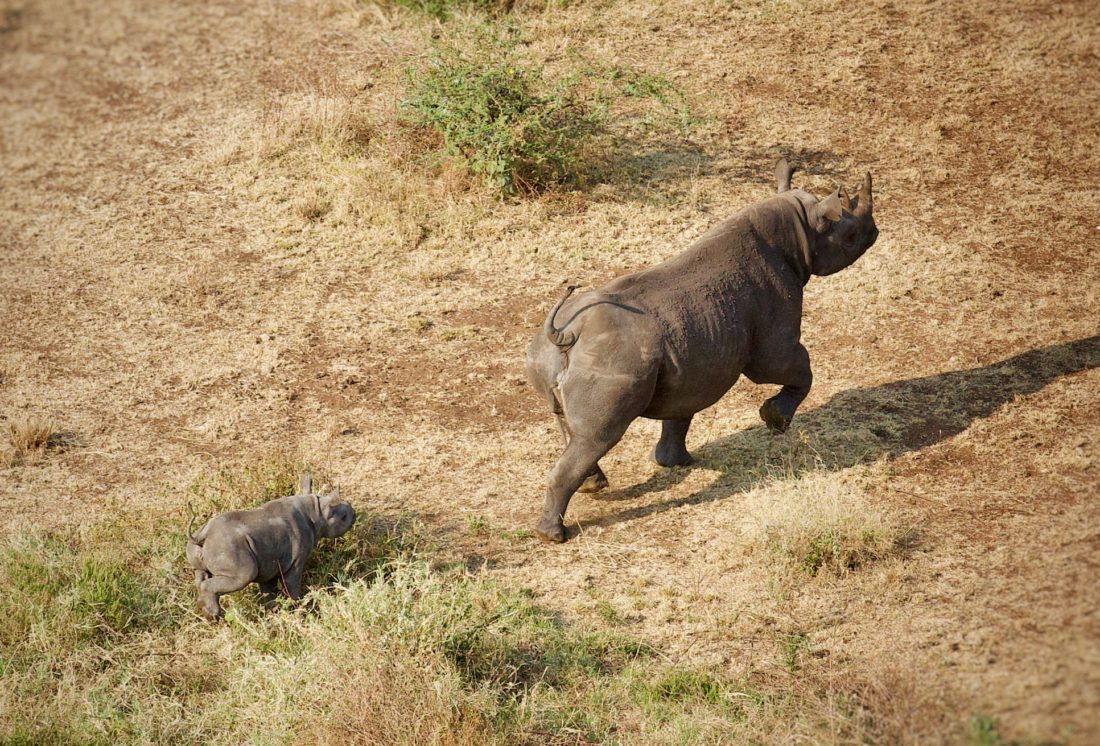Black Rhino Calf is Born!
With less than 1,000 left in the world, eastern black rhino are critically endangered. Endemic to East Africa, their numbers dwindled as poaching for rhino horn surged in the 1970s and ’80s. However, due to the work of a number of organizations, we are starting to see that number increase once more. With the birth of our first-ever eastern black rhino calf, we are proud that the Black Rhino Re-establishment Project, done in close collaboration with Tanzania’s Ministry of Natural Resources and Tourism, is a part of this species’ comeback story.

Since the inception of the Grumeti Fund in 2002, bringing eastern black rhino back to the western Serengeti and establishing a founder population to contribute to the overall genetic pool and bolstering of the greater Serengeti-Mara ecosystem rhino population has been a major goal of the organization.
In 2019, the Grumeti Fund, with the blessing of – and in partnership with – government stakeholders (primarily the Ministry of Natural Resources and Tourism and the Tanzanian Wildlife Management Authority), translocated a breeding nucleus of rhino that were living in an out-of-range population in South Africa. Their ancestors had been removed from East Africa during the poaching crisis of the ’70s with the intention of saving the species and bringing them back to their rightful home when the time was right. With a significant reduction in poaching in our area and a well-established anti-poaching force – that includes but is not limited to a special operations group, an intelligence-gathering unit, a mobile patrol unit, a canine unit and an airwing – our confidence in being able to protect these animals is greater than ever. After an arduous journey that involved crates, trucks, airplanes and more trucks, the animals arrived in Grumeti in September last year. It was mandated that they remain in specially built rhino bomas (enclosures) for a couple of months to acclimate, and in November 2019 they were released: free to make the western Serengeti their home.


 Thus, it is with great excitement that we can announce the birth of the first eastern black rhino in the western Serengeti in decades! Lindiwe, one of the females brought from South Africa has given birth to her first baby. The calf is now two months old and thriving.
Thus, it is with great excitement that we can announce the birth of the first eastern black rhino in the western Serengeti in decades! Lindiwe, one of the females brought from South Africa has given birth to her first baby. The calf is now two months old and thriving.
When the aerial team first spotted the newborn, excitement-levels ran high. Then came nerves. Extremely thick vegetation made it easy for her to hide the calf, but also increased the risk of predation. The calf remained elusive for two weeks after the initial sighting and we feared the worst. Fortunately, as the weeks went by, the first-time mother and baby continued to do well. Now, as the wildebeest migration has moved in, the grass is being eaten and trampled and it is much easier for our ground teams to monitor the mother and calf. Our fears of the calf succumbing to predation are still there, however the ubiquitous wildebeest herds have become the focus of hungry carnivores and significantly reduced the predatory pressure and associated risks for the rhino pair.

This calf’s birth represents the culmination of many years of hard work, dedication, healthy partnerships and the technical ability to relocate black rhino over long distances to new habitats. We expect to see at least one more calf born this year and, all going well, the speed at which their numbers are rebounding is very encouraging.
The monitoring and security of Lindiwe and her baby, as well as all of the other rhino, is a full-time job. There is a dedicated rhino monitoring team, a combination of Grumeti Fund and TAWA personnel, that track the animals daily. While it can be stressful when rhino move into new or far-off areas, it is also why we brought them here…to repopulate and add value to the entire ecosystem, not just the Grumeti concessions. Our aerial unit is also out looking for the rhino regularly as is the mobile patrol unit. The rhinos’ locations are logged in EarthRanger, the real time data visualization platform developed by Vulcan Inc., that collects and collates all data on assets, incidents and wildlife reports across the protected area, thus allowing us to track and monitor the rhinos’ movement on a daily basis and in near-real time.


We are still on a mission to introduce a full founder population of eastern black rhino. Unfortunately, COVID-19 derailed plans for the movement of the next cohort of rhino to Grumeti in late 2020, but plans are still moving forward, and we are hopeful that the next phase and translocation will take place in 2021.
To all who have been a part of this ambitious and visionary project, thank you. Your support, which has come through in so many ways, is greatly appreciated. We will forge ahead and ensure that despite these dark times, this story of the resurrection of a species continues to have a happy ending.
To those who are interesting in contributing to the continuation of the conservation of eastern black rhino in the western Serengeti, you can donate here.




